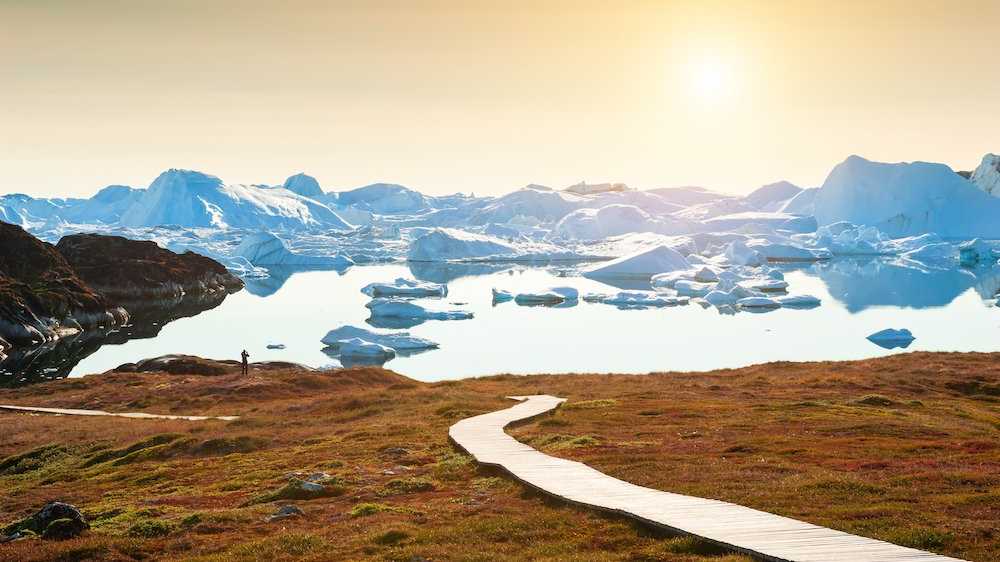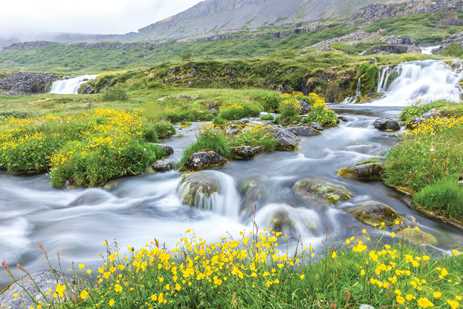Unlike the peaks of mountains that take centuries to change, icebergs etch new landscapes every day. As they melt and bump into each other, they pivot and spin to reveal new shapes and silhouettes. Icebergs dot the ocean in many parts of the Arctic, but from the walking trails that wind along the edge of the Ilulissat Icefjord, a UNESCO World Heritage Site in western Greenland, the icebergs are so concentrated that they fill the landscape. It’s a stunning combination of ancient and ever-changing: the ice that forms those bergs might be 250,000 years old, but your view will transform every hour as they shift, roll, and jostle towards the ocean.
Get Inspired By Photos, Videos, Webinars, Stories, And Exclusive Offers.
Sign Up
The Ilulissat Icefjord: In a Class by Itself
This spectacular fjord extends about 60 miles between one toe of the Greenland ice sheet, at a glacier called Sermeq Kujalleq, and the Arctic coast near the town of Ilulissat. Sermeq Kujalleq is one of the most active glaciers in the world. It can move in the range of 130 feet per day, and it calves an enormous amount of ice into the fjord, which acts like a long, skinny container. The container gets filled up at one end by the glacier, but an underwater shelf of rock and gravel at the other end—near the town and the walking trails—makes it difficult for the ice to escape. The result is an entire channel choked with icebergs throughout the summer and fall. From a lookout at the end of a sturdy boardwalk, you can gaze straight ahead and see nothing but sculptures of ice.
There don’t seem to be any weather conditions that make icebergs less gorgeous. They pop out in bright relief when the sky is blue, and they soften to a dreamscape when the fog rolls in. In addition to being gorgeous, they’re attractive: Icebergs draw travelers like a magnet. Locals who fish rely on the rich habitat they provide, humpback and minke whales patrol them, and seabirds soar between them.
One truth of the Arctic is that ice creates an abundance far beyond beauty. At the Ilulissat Icefjord you can witness for yourself nature’s stunning artistry, perfected over the millennia.
An exterior shot of the Icefjord Center nestled within the ruggged landscape. Photo: Courtesy Jeppe Kjaar/Icefjord Centre
Discover the Story of the Ice
In the summer of 2021, the brand-new Icefjord Centre welcomed visitors for the first time. Housed in a visually-stunning building designed by architect Dorte Mandrup, the steel, wood, and glass structure features a unique geometric shape that at once blends in and stands out among its stark natural surroundings. Mandrup describes her poetic source of inspiration as a “snow owls flight over the landscape.”
Once inside, prepare to be taken on an extraordinary journey into Greenlandic nature and culture. The permanent exhibition, “Sermeq pillugu Oqaluttuaq–The Story of the Ice," merges sound, images, and a tactile universe to reveal details about the cycle of the ice, the region's abundant wildlife, and the people who have adapted over centuries to living in this extreme climate.
One of the exhibition's highlights, ice cores from Greenland's vast ice sheet are on display, each layer concealing ancient air bubbles preserved for millennia in a frozen state. Also, look out for two additional art installations, a cinema, gift shop, and cafe, as well as the rooftop terrace offering jaw-dropping panoramic views.
This new center is sure to enhance your experience and it's conveniently located within walking distance of the icefjord so whenever you're ready, take the boardwalk outside, head past the old Inuit settlement of Sermermiut, and it will lead you down to the water's edge where you'll come face-to-face with this magnificent natural wonder.







